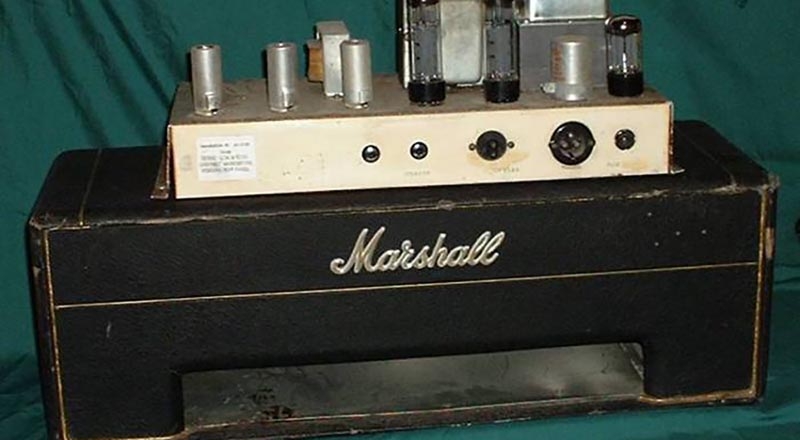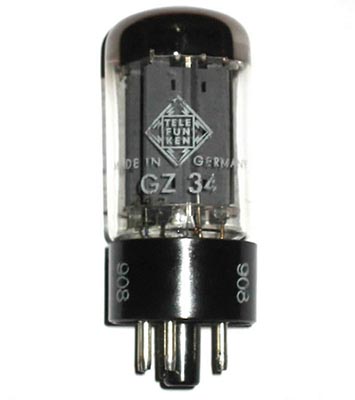
…let me introduce myself, my name is Jason and I’m a gear idiot.
Now. Having said that, I have been playing the guitar for WELL over 30 years, but I’ve always been more concerned with trying to play this virtuoso piece or if I can perfect the art of using the whammy bar to drop a note by a perfect 5th rather than thinking about why one amp sounds different than another, I’m guessing that many other players out there are like me as well, so following on from the piece I did about standby switches last year, I’m going to try to educate myself on these things, write them down, and hope that you guys join me on the learning journey as well. I can’t guarantee that this is going to be 100% unbiased as I’m considering it all out loud in a real world situation from an uneducated perspective, but here goes, hopefully, it all makes sense…
One of the things that has often comes up, especially in the more expensive amps, is that having a tube rectifier is a good thing (I when I started reading about this I couldn’t even begin to understand why some amps even have an option for both) – but, I’ve always just accepted that, but to be fair I have no idea what one is. So, I’ve asked people, Google, the dog, and my local milkman and here is the answer. A rectifier converts the power coming in from the wall from AC to DC. Well, that’s that answered then. Shall we go jam and have a beer?
Of course, we can’t, we have to ascertain the differences between different rectifiers, how different tubes make it sound different, why some amp builders insist that solid state is best – case in point – which was part of the first thing I read when looking at this, Mr Mike Soldano:
“In my opinion, all amps should have solid state rectifiers. I don’t believe there are any really good rectifier tubes on today’s market and, even if there were, why use them? The technology is obsolete; they are horribly inefficient, and far more expensive and troublesome to build into an amp. These tubes, no matter how good, will routinely need replacing, adding to your maintenance expenses. Besides that, tube rectifiers kill the headroom of an amplifier. If you want that spongy, vintage sound, there are other ways to do it. I have successfully designed and built amps that have replicated that soggy bottom, vintage tube rectifier sound using solid state rectifiers and various circuit modifications.”
This melted my head a little to start off with because I always thought that tube was best when it comes to tone. So, trying to ascertain why, I read further and talked to the dog some more.
I found that the beauty of the tube rectifier, which in real terms can also be the beast of it, is SAG. And yes, there’s that word again. Starting to think it’s a nonexistent word invented by guitary types to describe something that the literary genius of before could not describe. So we just call it SAG. Now, SAG occurs when the rectifier is hit with a request for massive amounts of current, usually if it’s working really hard. Almost like my understanding of the SAG that happens when you are at high gain and you slightly palm mute, everything goes crunchy and saggy, because the low end is requesting a HUGE amount of power and something has to give. In my head, this is a very good thing, but also it can be a bad thing as well, because if the power you are getting from the wall is under par, you will achieve SAG quicker… if the tube is on it’s way out, you will achieve SAG quicker. So, once again (as with ANY discussion with tube amps), consistency is the key. Trouble is, most of us prefer the sound so much we are prepared to run this risk. The effects of SAG on a rectifier is that there is a slight delay, literally milliseconds in the response which then goes on to make the note bloom (as the rectifier catches up) which at the same time evens out the high end. Pretty certain most of us players will read a line like that, gently nod and maybe give a little smile, as that is ALWAYS a good thing. Then you get into differing types of tubes that force this behavior to make it happen quicker (for example, a 5Y3 is quicker than a GZ34), you start to understand that part of the rectifiers character and how it is dealt with plays a massive part in amps, and also plays a massive part many of guitar pedals trying to rectify that sound… Let’s face it, if you are anything like me as you were reading that last paragraph you probably thought at some point about a decent compressor and a tube screamer!

Let’s look at the other end of the scale now. The Solid State rectifier. These are made from silicon and do the same thing as the tube version, just extremely consistently. In my head, my first reaction to that is “YAY, consistency, GREAT” but then I remember those gigs I’ve played where my amp has never sounded bad because of the rectifier, just the times when it has sounded glorious. You know the ones I mean, the ones where something happens somewhere and for some reason, everything is compressing at the right time, the right amount, at the right volume, the notes are blooming, harmonics are leaping out and just everything else… I just wish it would happen more often. I suppose the challenge the builders of the future have it to make that happen, all the time, at all volumes.
I asked Brian why he opted for a tube rectifier in his amp designs, his answer was simple:
“To rectifier has a little bit more natural compression, and notes that are distorted sometimes feels more pronounced. Since this amp is fairly clean it just feels better with the tube. Solid-state will be much stiffer feeling”
So, we are back with the whole consistency feel and that “X Factor” thing of things magically happening under your fingers, why is it that when we talk about tube amps, we always come back to that? Playing the guitar is fundamentally an organic experience, for most of us anyway, we tend to dig that whole signal chain reaction that comes from a great player, great guitar, great cables, great pedals, great amp, great speakers. There is something delightful when those things work together to get that point, many many players rely on the inconsistencies of tube amps to get their tone and to keep them on their toes… yet many companies provide their amps with either both, or just SS. Why? I’m guessing that in amps where the gain response (clipping) is everything and the signal is being carefully balanced across gain stages, you will want the same thing, day in and day out and you don’t want your amp to one minute to have a much more saggy low end appearing at random times, because with a lot of natural clipping happening, it would legitimately change the entire personality of the amp. Notable amps that have an SS (or both) rectifier: Soldano SLO100, Many Marshall Plexi’s, Blackface Twin reverbs… the list is extensive!



https://www.premierguitar.com/articles/28175-signal-to-noise-demystifying-the-tube-rectifier